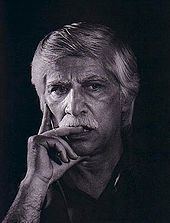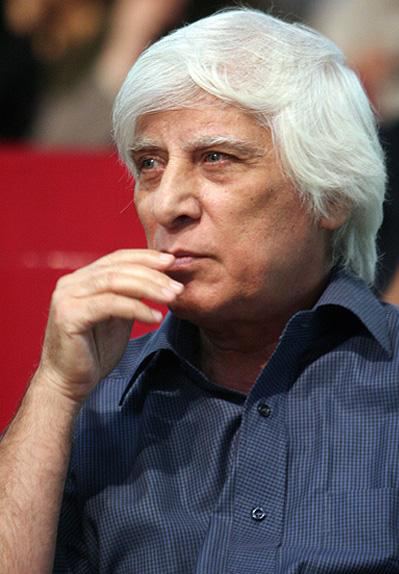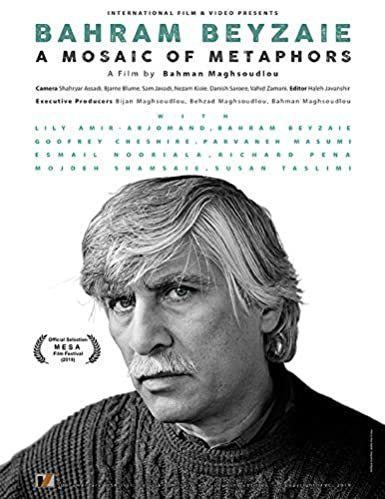Years active 1962– Spouse Mozhdeh Shamsai (m. 1992) | Role Film director Name Bahram Beyzai Children Niloofar Beyzaie | |
 | ||
Occupation Playwright, Film director, Theatre director, Screenwriter Books Memoirs of the Actor in a Supporting Role, Modern Persian Drama: An Anthology Movies Bashu - the Little Stranger, Killing Mad Dogs, Death of Yazdgerd, Ballad of Tara, Downpour Similar People Mozhdeh Shamsai, Susan Taslimi, Niloofar Beyzaie, Dariush Mehrjui, Dariush Farhang | ||
Parents Ostad Ne'mat'ollah Beyzai | ||
"Analytic View of the Legend of Rostam and Sohrab" by Bahram Beyzaie
Bahrām Beyzāie (also spelt Bahrām Beizai, Bahrām Beyzaie, Persian: بهرام بیضائی, born 26 December 1938) is a Persian Ostad of arts; a critically and popularly acclaimed film director, playwright, theatre director, screenwriter, film editor, film producer, and researcher.
Contents
- Analytic View of the Legend of Rostam and Sohrab by Bahram Beyzaie
- The Meaning of Shahnameh as a Social Work Part 12 by Bahram Beyzaie
- Early years
- Playwriting in the 1960s
- 1970s and the outset of a cinematic career
- Filmmaking in the 1980s
- 1990s another trip a film and some plays
- After 2000
- Cinematic style
- Reception and criticism
- Filmography as director
- Plays
- Honors
- References

Bahram Beyzaie is the son of the poet Ostād Ne'mat'ollāh Beyzāie (best known by his literary pseudonym Zokā'i Beyzāie - ذکائی بیضائی). The celebrated poet Adib Beyzāie, considered as one of the most profound poets of 20th-century Iran, is Bahram Beyzaie's paternal uncle. Bahram Beyzaie's paternal grandfather, Mirzā Mohammad-Rezā Ārāni (Ebn Ruh - ابن روح), and paternal great-grandfather, the mulla Mohammad-Faqih Ārāni (Ruh'ol-Amin - روح الامین), were also renowned poets.
In spite of his somewhat belated start in cinema, Beyzai is often considered a pioneer of a generation of filmmakers whose works are sometimes described as the Iranian New Wave. Still, even before the outset of his cinematic career in 1970, he was a greatly successful playwright, so much so that he is often considered the greatest playwright ever of the Persian language, and holds a reputation as "The Shakespeare of Persia."
"The Meaning of Shahnameh as a Social Work" (Part 1/2) by Bahram Beyzaie
Early years

Beyzaie was born in Tehran, to a poet, anthologist and biographer father and a housewife mother. Zokā'i Beyzāie made a living through a legal occupation and was able to attend to his literary interests reasonably.
The young Bahram did not seem very interested in his family legacy, being poetry, which was pursued by his father, uncles and cousins. In high school, the Dar'ol-Fonoun, he wrote two historical plays which went on to become his preferred method of writing. He started skipping school from around the age of 17 in order to go to movies which were becoming popular in Iran at a rapid pace. This only fed his hunger to learn more about cinema and Iranian visual arts.
After school, and after a year of waiting before passing the competitive examination for university admission and meanwhile reading the Shahnameh, he began to study Persian literature at the University of Tehran. But it became impossible for him to stay in the university, particularly because his professors would not accept his researching Persian theatre as a graduate work, arguing that "Persia has had no theatre."
At the age of 21 he did substantial research on the traditional Persian plays, particularly Ta'zieh, and by 1961 he had already spent a great deal of time studying and researching other ancient Persian and pre-Islamic culture and literature. This in turn led him to studying Eastern theatre and traditional Iranian theatre and arts which would help him formulate a new non-Western identity for Iranian theatre. He also became acquainted with Persian painting.
Playwriting in the 1960s
By late 1961 he had already published numerous articles in various arts and literary journals. In 1962 he made his first short film (4 minutes) in 8 mm format. In the next two years he wrote several plays and published "Theatre in Japan".
In the next eight or so years of his life throughout the early to late 1960s, Bayzai dedicated himself to writing in various publications about Eastern art and Persian literature enabled through his extensive study and also wrote a number of essays about Iranian cinema which later became the subject of one of his books. It is during this period that he wrote popular plays which are often regarded as masterpieces; Sindbad's Eighth Voyage, Banquet, Serpant King, The Marionettes, The Story of the Hidden Moon and many more.
In 1968, Beyzaie became one of the first people to join the Iranian Writer's Guild, a highly controversial organization in Iran in the face of censorship, known as the Kanun-e Nevisandegan-e Iran.
His daughter, Niloofar Beyzaie, is a theater director and playwright. He has two daughters and one son. Beyzaie's early study and interest in drama and the theatre is well known, but less well-known is his early work as a dramatist. As a young man Beyzaie had always been fascinated by the traditions of Iranian theatre, and this included the puppet theatre. His "Se Nemayeshname-ye 'Arusaki" ("Three Puppet Plays") was published in 1963, and The Marionettes was the first one of these three plays. But for all that it is unmistakably based on the model of the traditional puppet theatre, "The Marionettes" is shaped by other traditions, too. It is the work of someone au fait with the work of Pirandello and the Theatre of the Absurd. In the 1960s, plays by dramatists such as Beckett and Ionesco were often translated into the Persian language and performed in Iran soon after their premieres in the West). Drawing on these varied influences, Beyzaie's play is a little-known master-piece of 20th-century drama. Beyzaie's A Study on Iranian Theatre (Namayesh dar Iran), published in mid-1960s is still considered the most important text on the history of Iranian theater. Beyzaie is also the first scholar in Iran to publish books on theatre of Japan and theatre of China.
Some of his plays such as his masterpiece Marg-e Yazdgerd (Death of Yazdgerd) have been made into films.
1970s and the outset of a cinematic career
In 1969 he began his film career by directing the short film Amu Sibilou (Uncle Moustache) followed by "Safar" in 1970. With these films Beyzai is often supposed to be a pioneer of what is called the Iranian New Wave, a Persian cinema movement that is supposed to have spontaneously started in the late 1960s, i.e. ignoring earlier efforts by filmmakers such as Farrokh Ghaffari and Ebrahim Golestan, and includes other outstanding directors such as Nasser Taghvai, Forough Farrokhzad, Amir Naderi, Ali Hatami, Sohrab Shahid Sales, Dariush Mehrjui, Abbas Kiarostami, Parviz Kimiavi, Masoud Kimiai and Fereydun Gole among others; and soon following Khosrow Sinai, Masoud Jafari Jozani, Kianoush Ayari, Varuzh Karim-Masihi, Ebrahim Hatamikia and others.
Immediately after, in 1971, he made his first feature film "Ragbar" ("Downpour") which is regarded by critics to this day as one of the most successful Iranian films ever made. The successful film addresses the late Parviz Fannizadeh as its central character and protagonist.
Since then he has produced and directed 8 films including Qaribe va Meh (Stranger and the Fog) (1974), Cherike-ye Tara (Ballad of Tara) (1979), Bashu, the Little Stranger (1986, released in 1989), Shāyad Vaghti digar (Maybe another time) (1988) and Mosaferan (Travellers) (1992).
Filmmaking in the 1980s
In 1981, the revolutionary leaders started the Iranian Cultural Revolution, as a result of which Beyzaie among many others was expelled from the university. He continued writing and making films though. His screenplay Ruz-e Vaqe'e (The Fateful Day) was adapted into a film in 1995 and another screenplay was adapted into a film named Fasl-e Panjom (The fifth season) in 1996, whilst he also made four of his finest films. He also edited Ebrahim Hatamikia's Borj-e Minu (Minoo Tower).
1990s: another trip, a film and some plays
He married the actress and make-up artist Mozhdeh Shamsai in 1992. After Mosaferan, he failed to get a permit for the production of a number of screenplays. In 1995 he left Iran for Strasbourg at the invitation of the International Parliament of Writers. Soon however he returned and staged The Lady Aoi in Tehran.
After 2000
In 2001 he made his best-selling film Killing Mad Dogs, after which he managed to stage three plays as well before he left Iran for the United States.
Cinematic style
He is known as the most intellectual and conspicuous “author” in Iranian cinema. The main theme of his works is the history and “crisis of identity” which is related to Iranian cultural and mythical symbols and paradigms. He is considered as Iran’s most prominent screenwriter in terms of dramatic integrity of his works, many of which have been made into films.
Reception and criticism
Beyzaie has made significant contribution to the development of the cinema of Iran and theatre and is regarded as an influential director and innovator of the Iranian New Wave movement of cinema. He is also considered Iran’s most prominent screenwriter in terms of dramatic integrity of his works, many of which have been made into films.
However, despite the value of his films and his substantial knowledge of the arts, like many other Iranian film directors such as Nasser Taghvai, Varuzh Karim-Masihi, Kianoush Ayari and many others, the Government of Iran has almost never supported his career, before and after the 1979 Iranian Revolution. Before the revolution he was handed in the best prize by the Queen Farah Diba in Tehran Film festival in 1972 as a new young director whose talent was lauded with appreciation and applaud for his Film Ragbar. After revolution now even after some 20 years, his films such as Ballad of Tara (1980) and Death of Yazdgerd (1981) have never received a screening permit in Iran. Both films have been shelved because they are not in accordance with the Islamic code currently in operation in Iranian motion pictures. Even Bashu, the Little Stranger almost saw the same fate in 1986 due to the subject matter of the film, i.e. the story of a little orphaned boy who lost his parents in the Iran-Iraqi war. The film was only legalized after the end of the 1980-1988 Iran-Iraq War and was released in 1989.
Critics have often praised Beyzai above all Persian filmmakers as well as playwrights. He was voted the best Persian filmmaker of all time in 2002, and his Bashu, the Little Stranger was voted the finest Persian film of all time. All the same, his formalism has occasionally raised criticism, even from himself. Ebrahim Golestan, who had previously made objections to Beyzai's style, praised him in a letter in 2017.
Filmography (as director)
Plays
Beyzaie has over 50 published plays, some of which are as follows. Theses works have occasionally appeared in French, English, German and other translations too.
Honors
The prizes, awards and honors he has won are numerous. Most recently in 2017, The University of St Andrews awarded Beyzai an honorary doctorate in letters.
